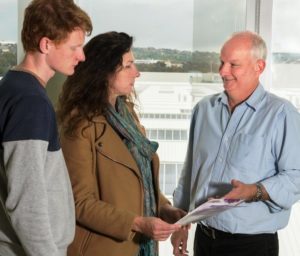
A major renewable energy and water management project in Holtville, California will build on a collaboration between Infratech Industries and Flinders nanotechnology and engineering expertise.
Australian sustainable infrastructure company Infratech, which this year opened its first floating solar system with the local council at Jamestown in South Australia’s Mid North, this month announced the first export of its renewable energy system.
In a first for Australian renewable energy exports, the bulk of the one megawatt floating solar system will be manufactured in Australia.
Its 3576 panels, 276 rafts and 12 treatment pumps will generate an estimated 20% more power than a fixed land-based system and power a new water treatment facility.
Infratech will continue to work with the Centre for NanoScale Science and Technology at Flinders to deliver the next generation system to the City of Holtville in California next year.
The Californian project brings new technologies to enable production of renewable energy, waste processing and water management systems to a region with rising demands for reliable water supplies and affordable green energy supplies.
“This move puts us ahead of the rest of the US,” says Holtville Mayor Pro Tem Mr James Predmore.
While not encroaching on valuable agricultural land in America’s so-called “Winter Salad Bowl,” the system will reduce evaporation and improve the quality of water for irrigation of more than 80 food crops and reduce the council’s reliance on fossil fuels and treatment chemicals.
“Installing Infratech’s floating solar system is the right move for Holtville, and further proves our progressive approach to infrastructure and the environment,” Mr Predmore says.
After opening its new US subsidiary, Infratech has plans to export to Indonesia and Europe.
Like in the SA’s Mid North, Infratech works with local councils and rural communities to use local water storage areas to generate affordable renewable energy while also purifying wastewater. The 300kg Jamestown floating solar array is putting renewable energy back into the local grid and powering the council’s water treatment facility.
Professor David Lewis, the director of Flinders Nano Centre, says the collaboration with the Sydney-based company commenced via the NanoConnect program with funding from the SA Department of State Development.
“This is an exciting working project which highlights the role of nanotechnology in old and emerging industries – and of the benefits of collaborations between these industries and the university sector,” says Professor Lewis.
“It’s a demonstration of how knowledge in universities can be used to help companies create commercial outcomes and compete on the world stage.”
NanoConnect is a collaborative research program which helps companies who understand how new technology and materials can positively impact their business and products.
It provides a simple, low-risk mechanism for companies to utilise the University’s research resources, such as advanced analytical equipment and technical knowhow.
Nano Centre research scientist Dr Leigh Thredgold was one of the Flinders postgraduates who will continue to help Infratech advance the next generation of solar infrastructure components, materials and systems.
The Infratech system claims to generate more than 50% more energy than rooftop solar and deliver consumers a saving of up to 15% on regular electricity prices.
Infratech chief executive Dr Rajesh Nellore says Jamestown, like Holtville, is an arid area subject to harsh climates and drought.
“Floating solar and other sustainable initiatives can ensure farmers have access to renewable power and clean water without losing valuable agricultural land,” Dr Nellore says.
“Jamestown and Holtville are proof points of what is possible when people look to sustainable infrastructure initiatives to power their communities.
“These projects also prove that Australian manufacturing has world-class expertise ready to be tapped for renewable energy, clean technology and other initiatives.”
California has a renewable energy target of 50 per cent by 2030. The system is expected to be fully installed and operational by mid-2016.

